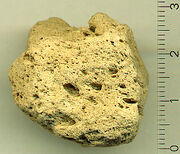
Specimen of highly porous pumice from Teide volcano on Tenerife, Canary Islands. Density of specimen approx 0.25 g/cm³. Scale is in cm.
Pumice is a textural term for a volcanic rock that is a solidified frothy lava composed of highly microvesicular glass pyroclastic with very thin, translucent bubble walls of extrusive igneous rock. It is commonly, but not exclusively of silicic or felsic to intermediate in composition (e.g. rhyolitic, dacitic, andesite, pantellerite, phonolite, trachyte), but occurrences of basaltic and other compositions are known. Pumice is commonly pale in color, ranging from white, cream, blue or grey, but can be green brown or black. It forms when gases exsolving from viscous magma nucleate bubbles which cannot readily decouple from the viscous magma prior to chilling to glass. Pumice is a common product of explosive eruptions (plinian and ignimbrite-forming) and commonly forms zones in upper parts of silicic lavas. Pumice has an average porosity of 90%, and initially floats on water.
Pumice has a very low density.